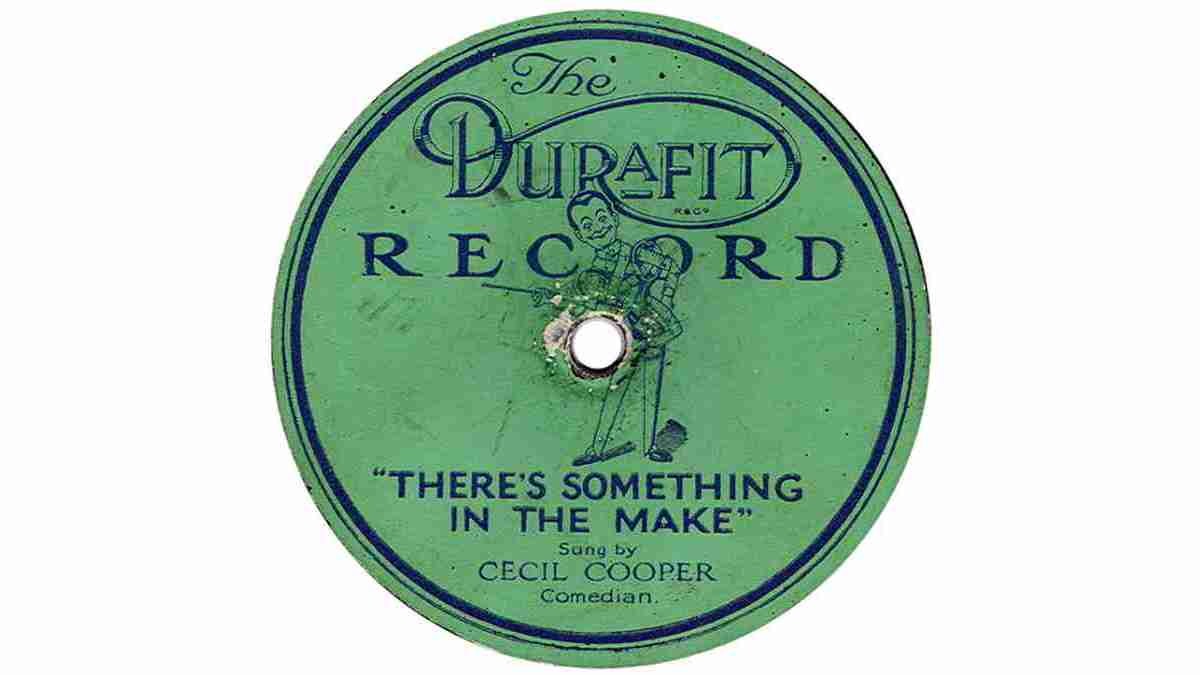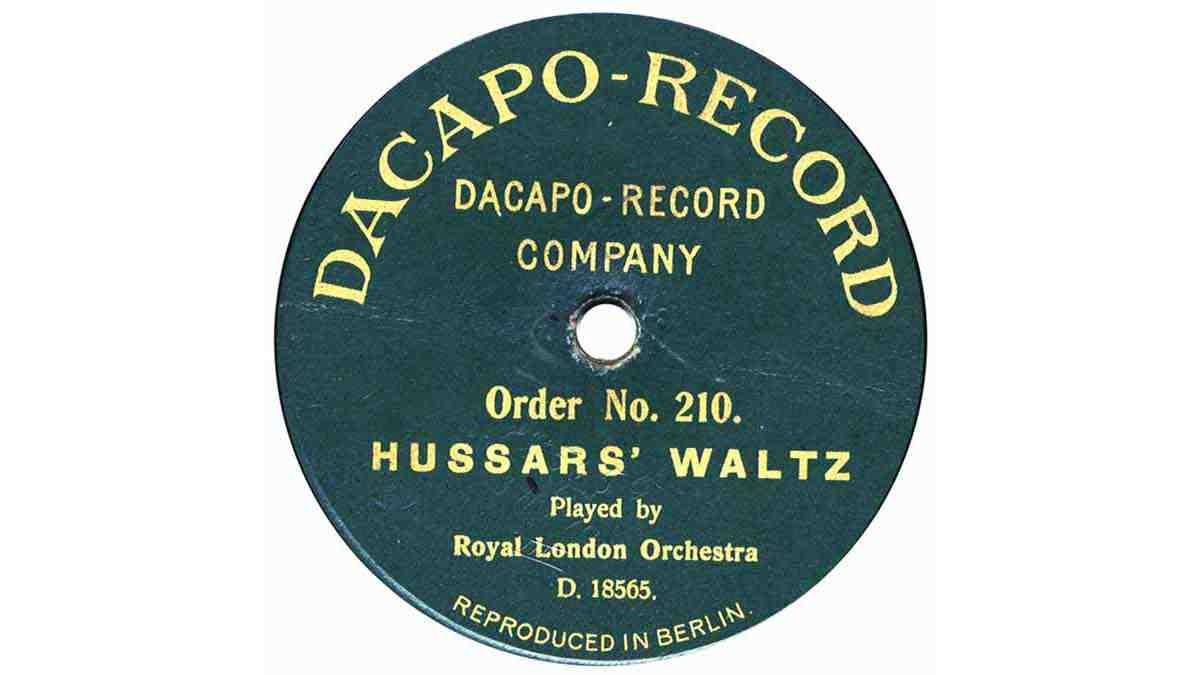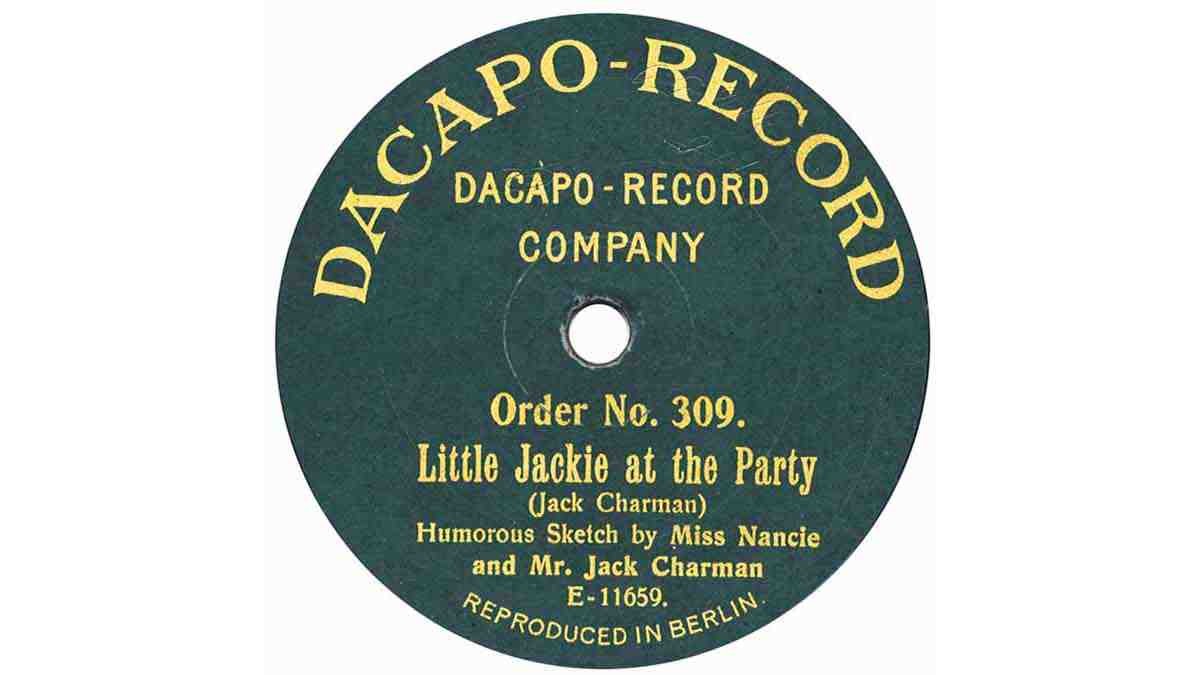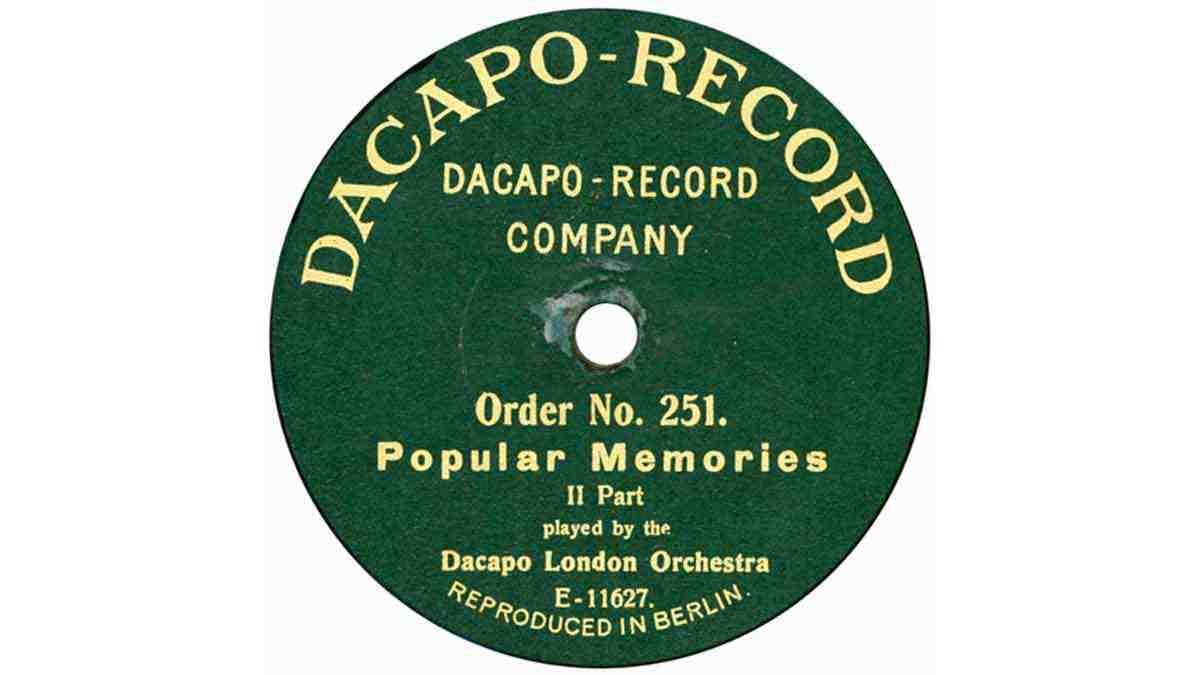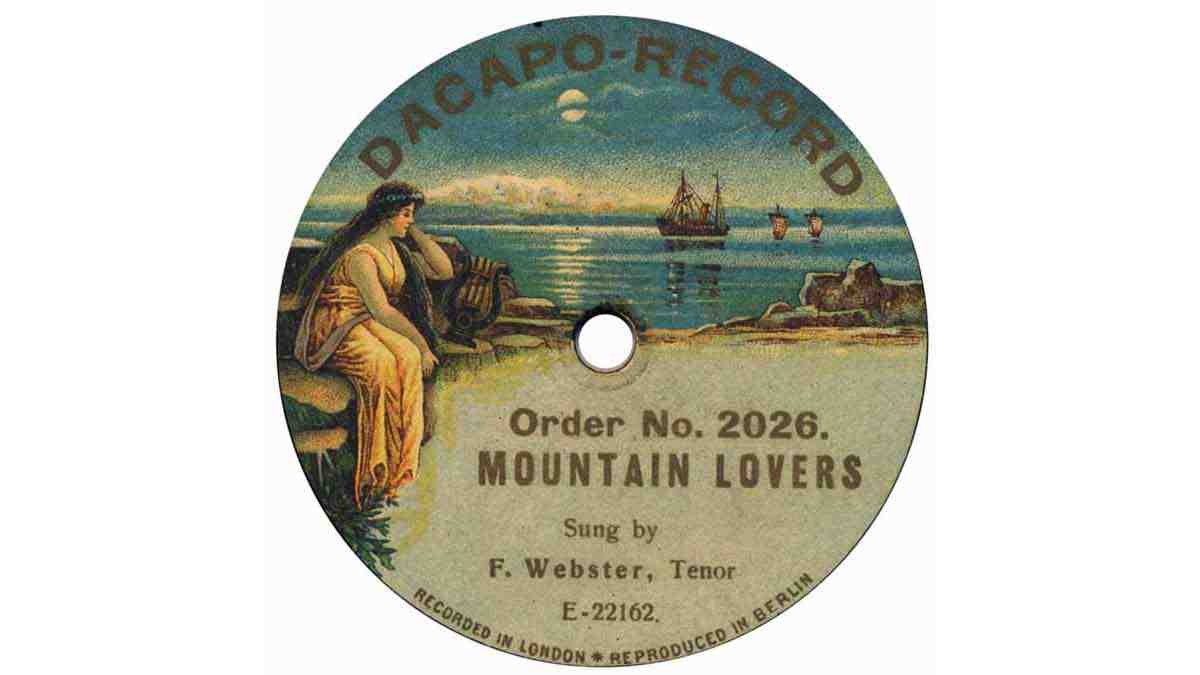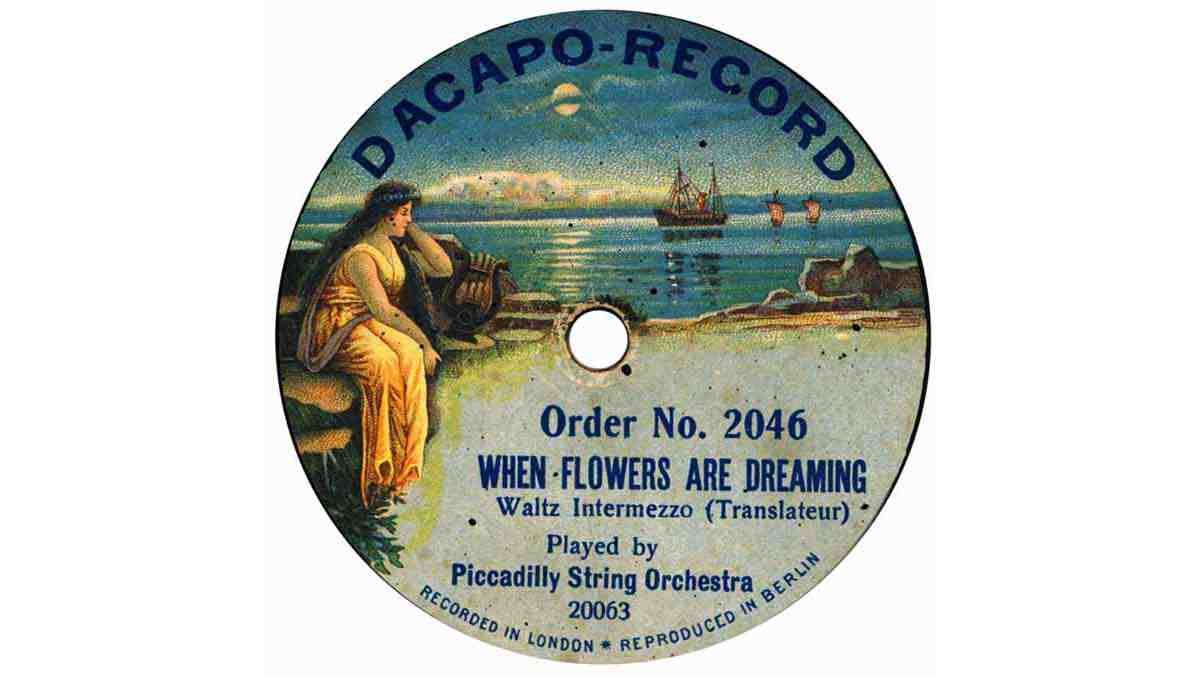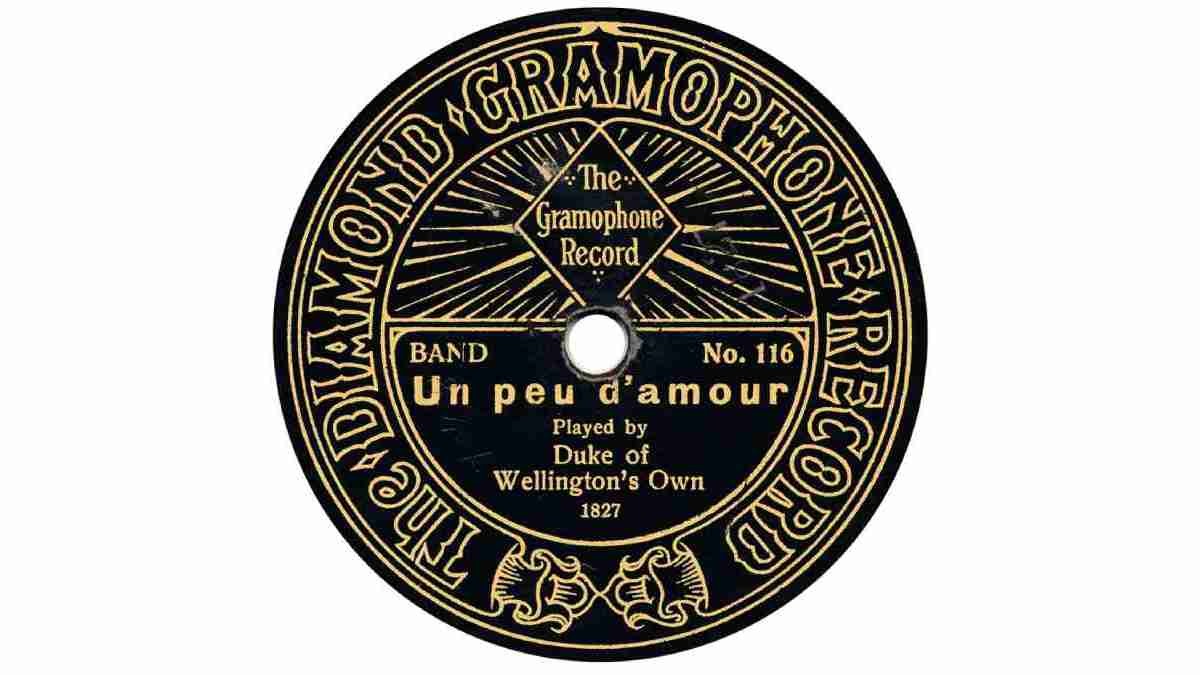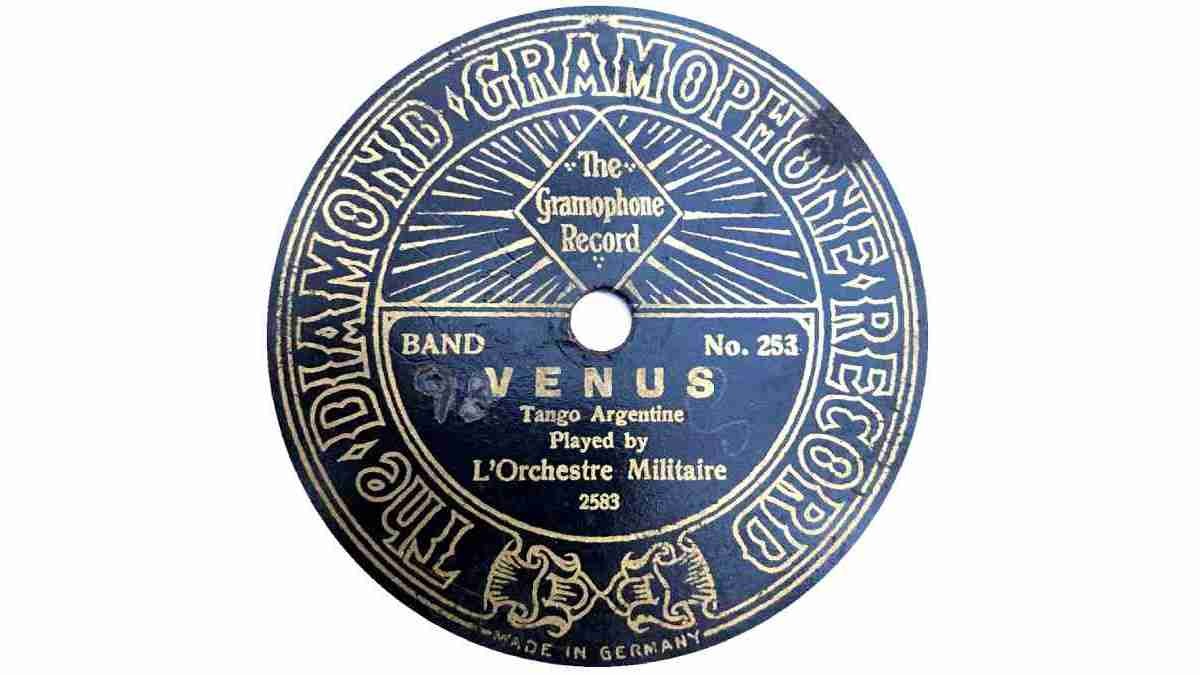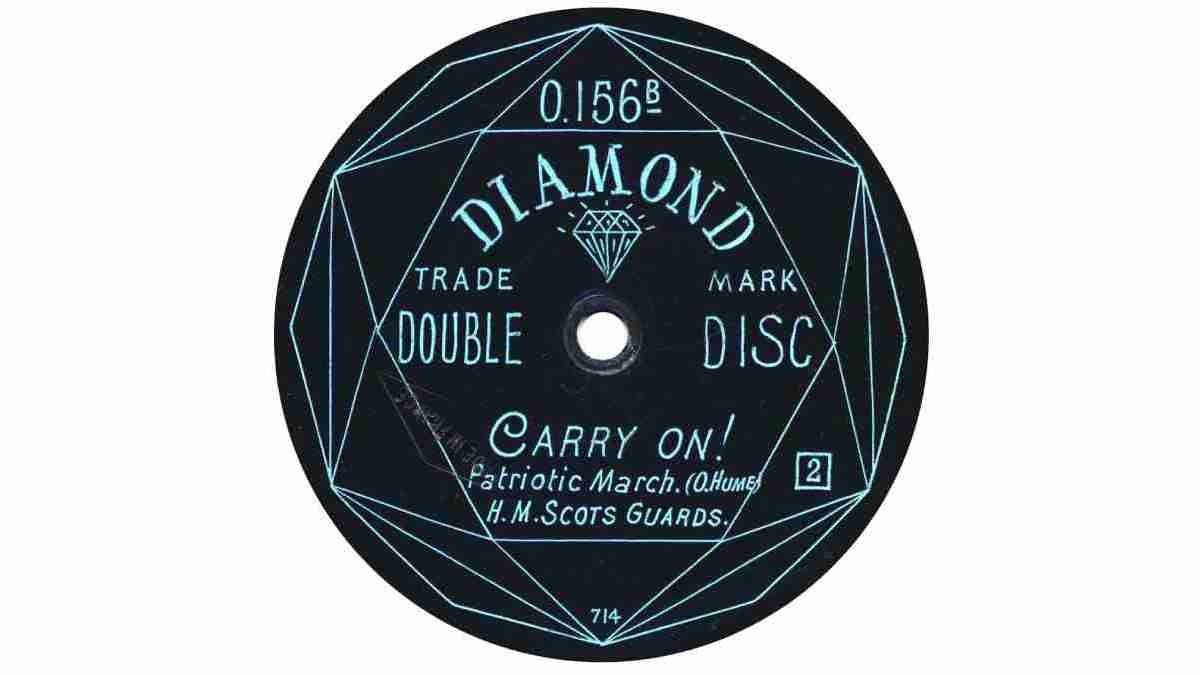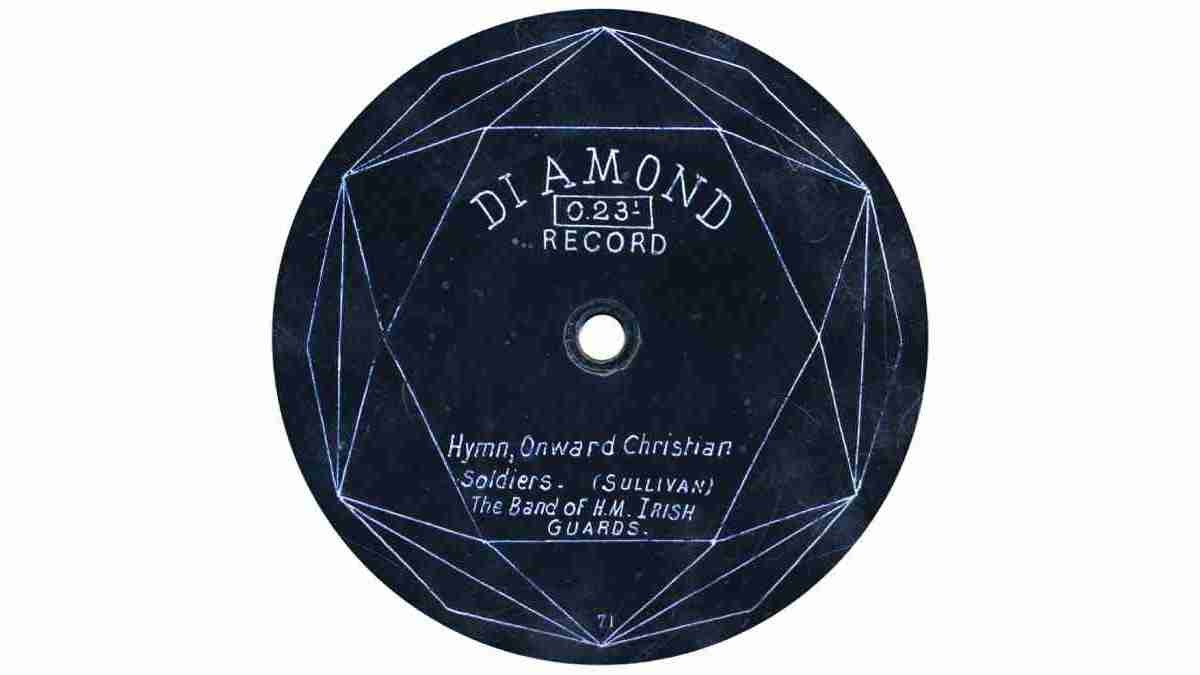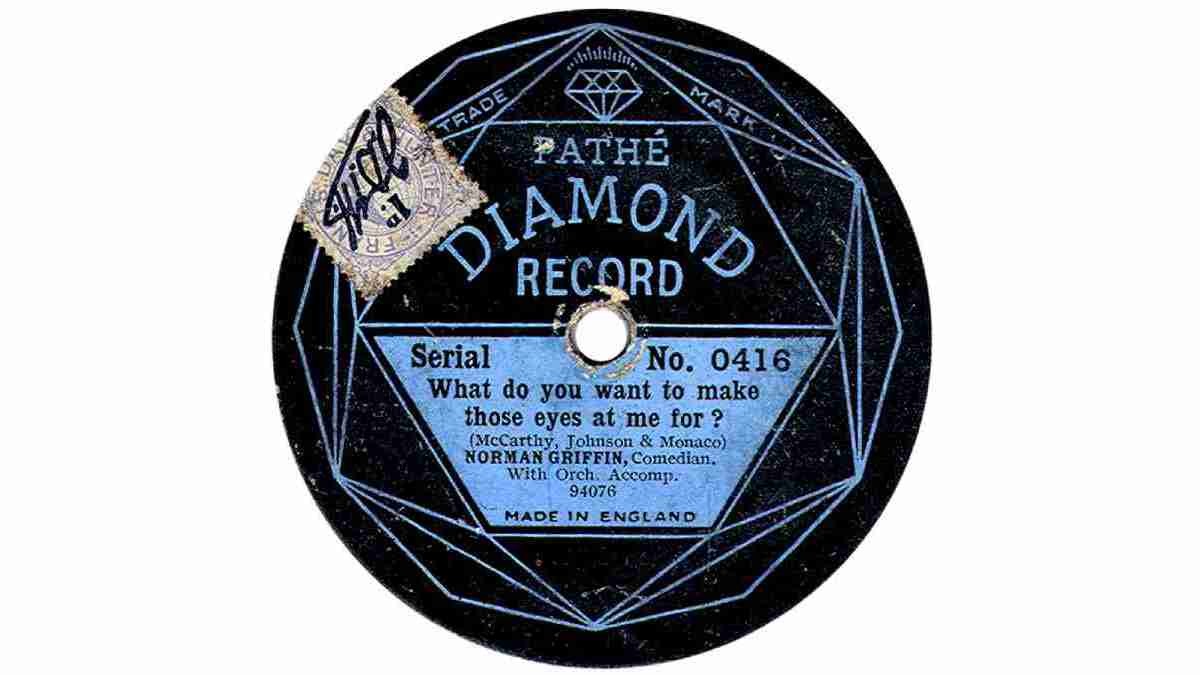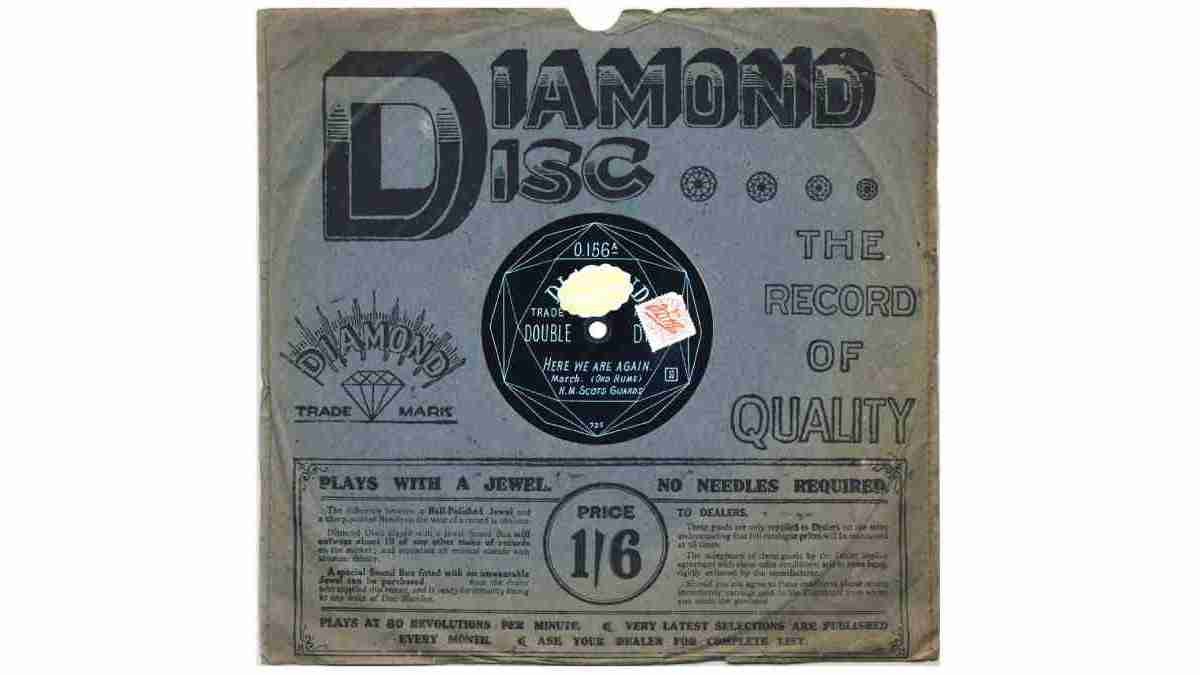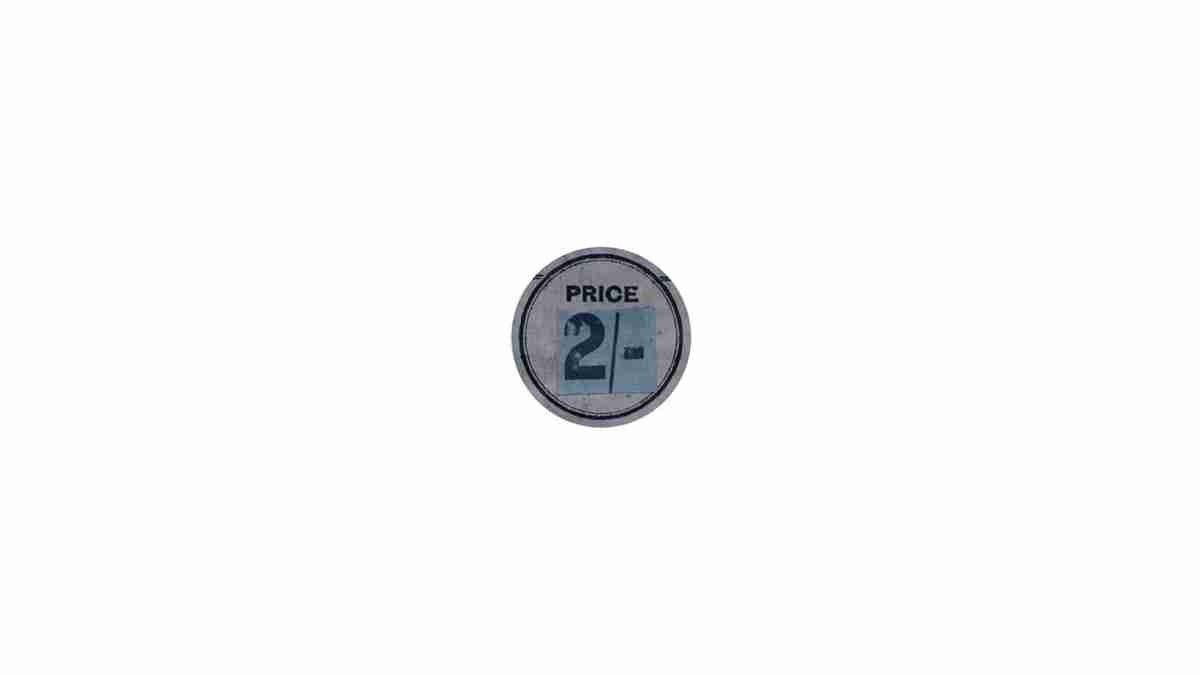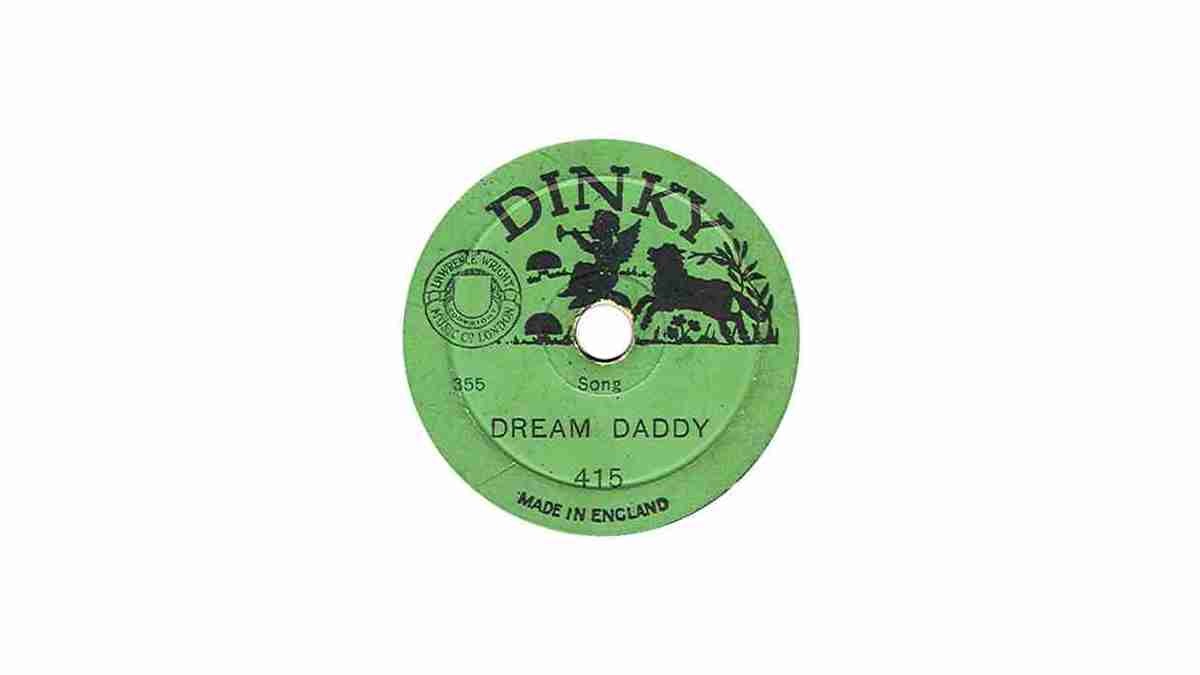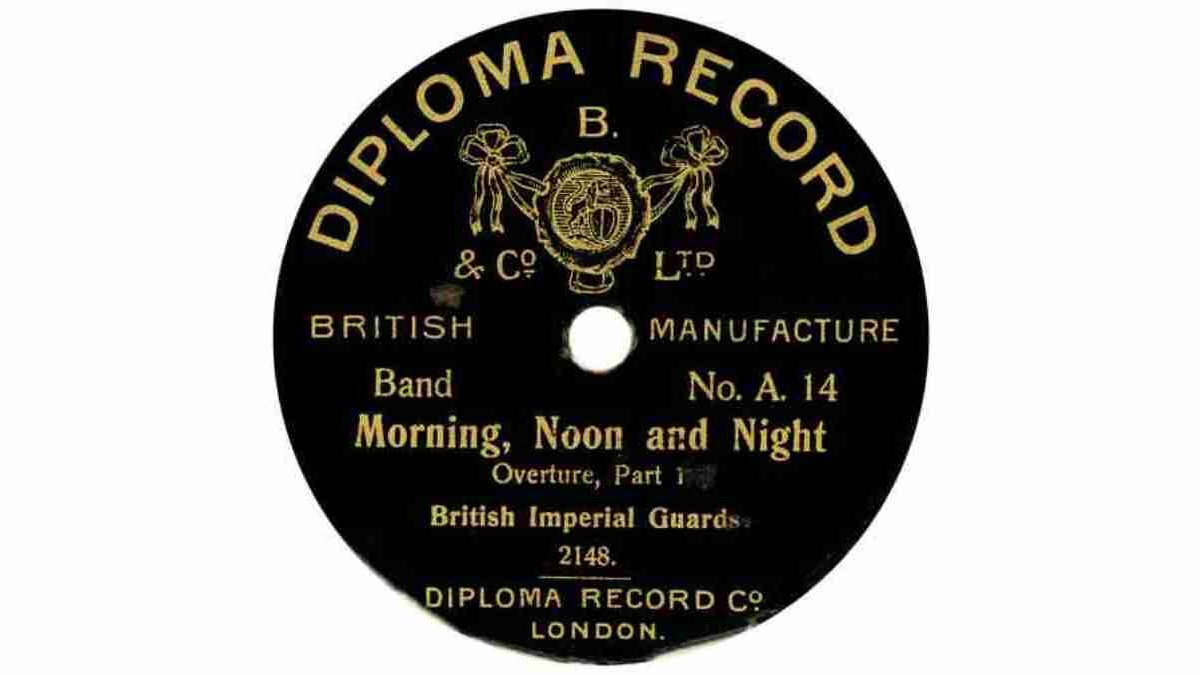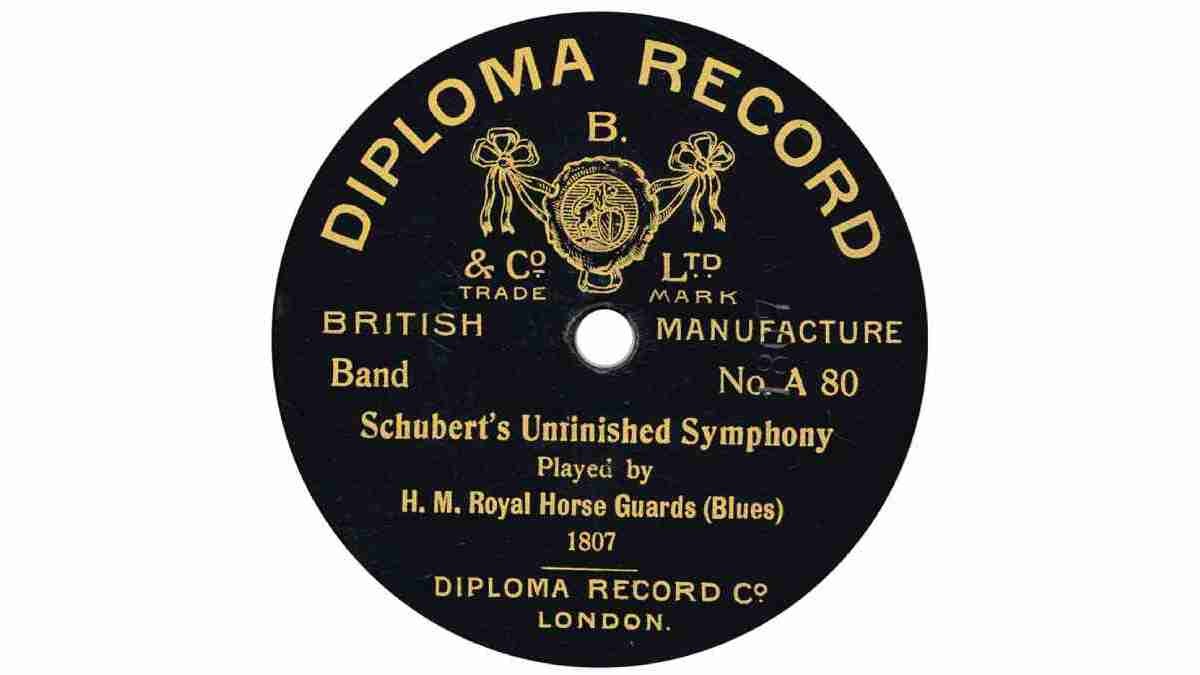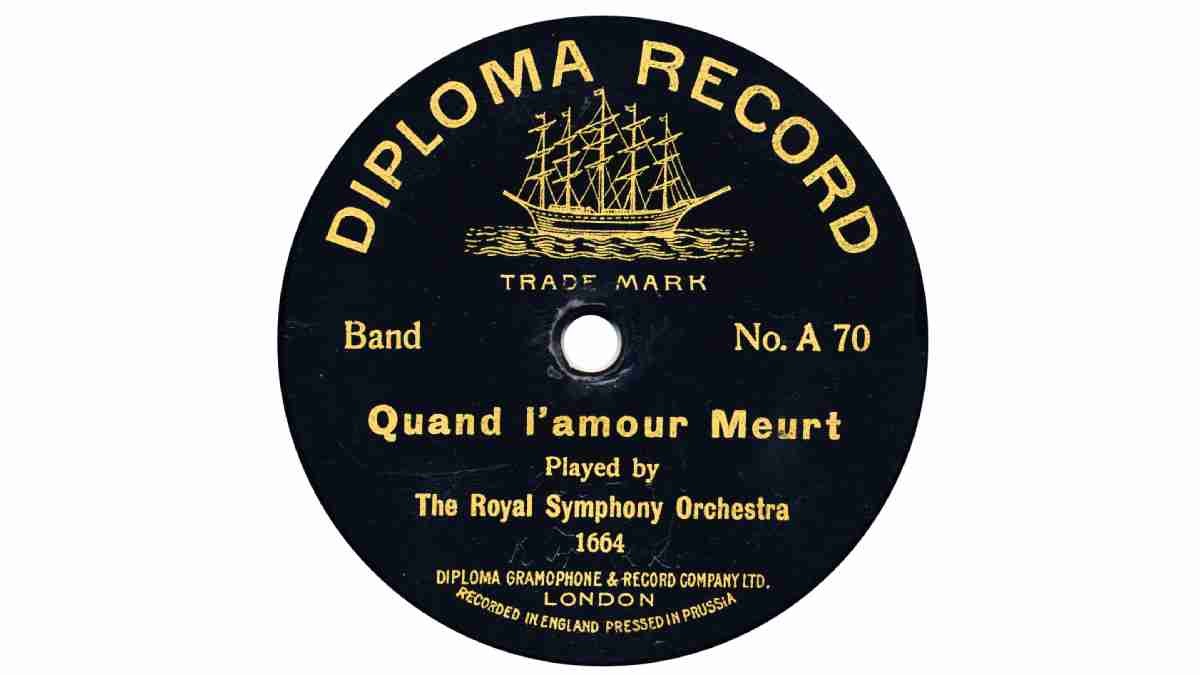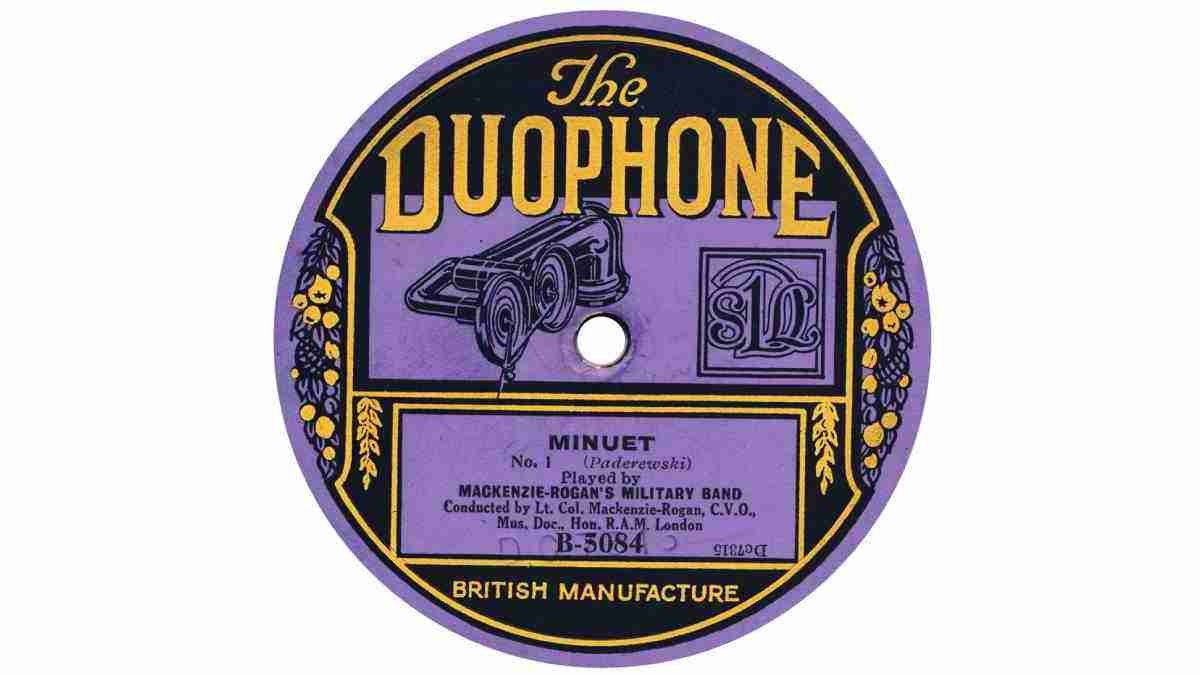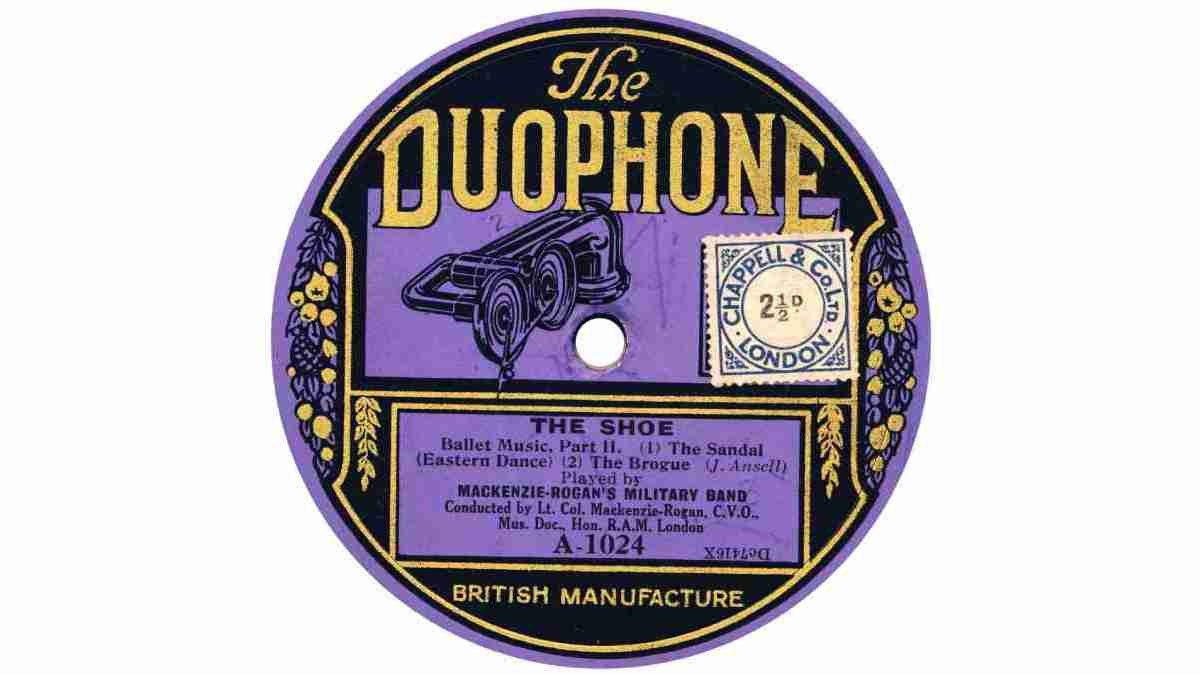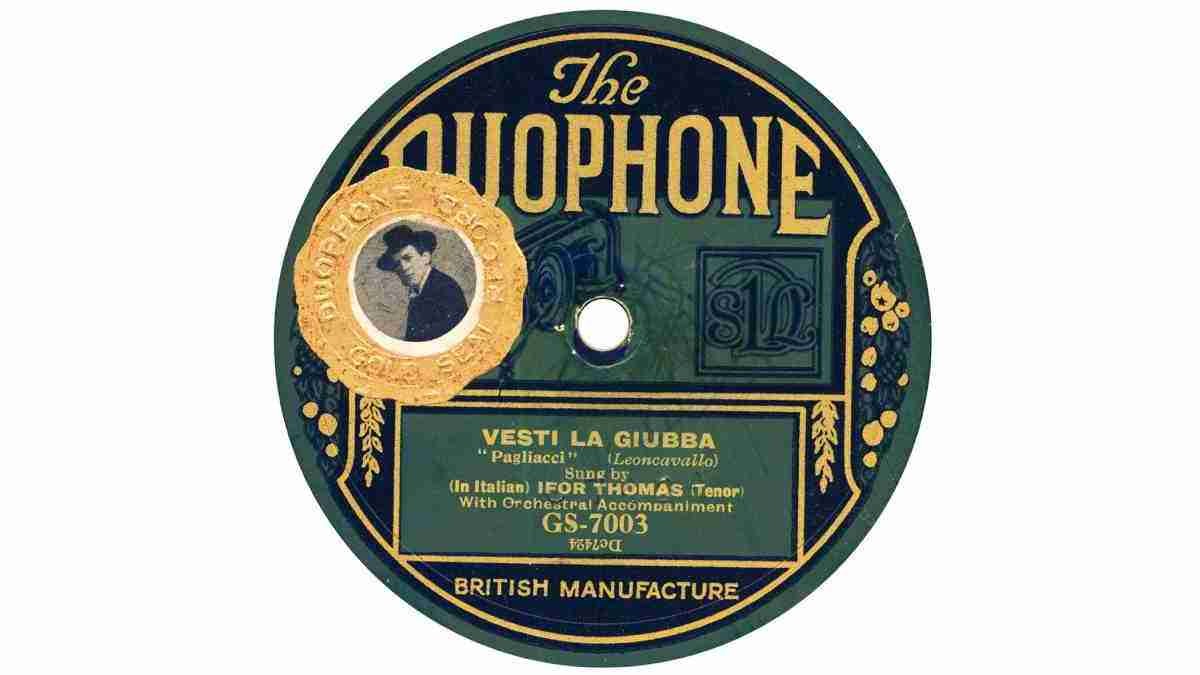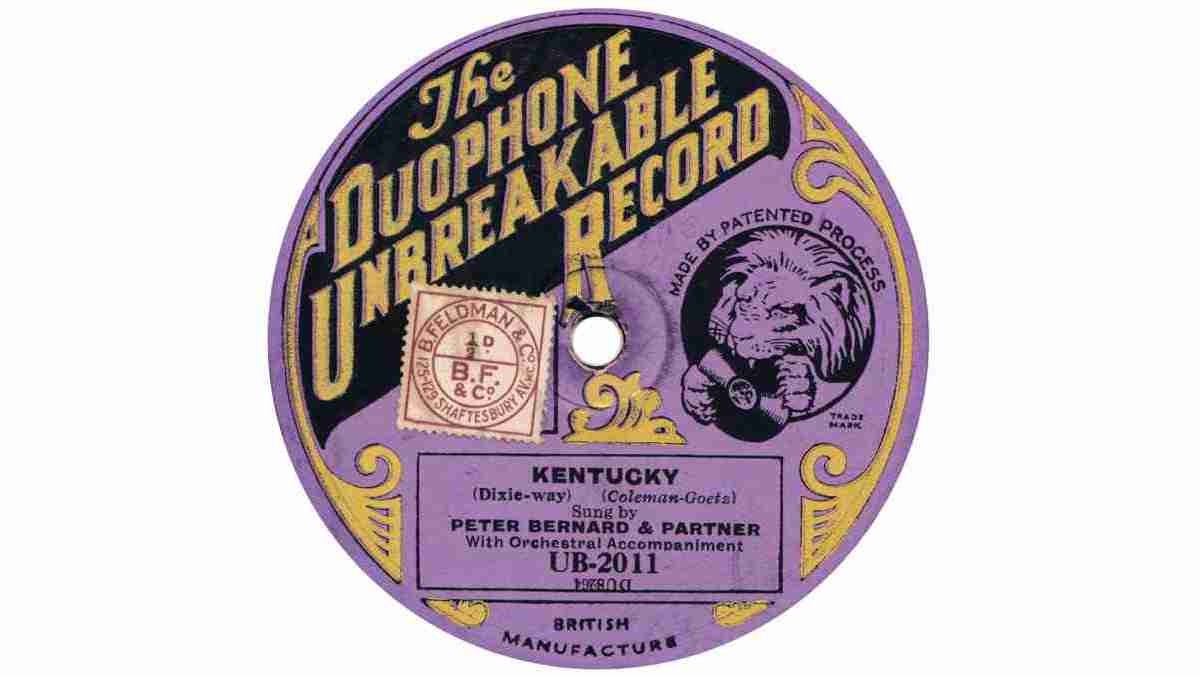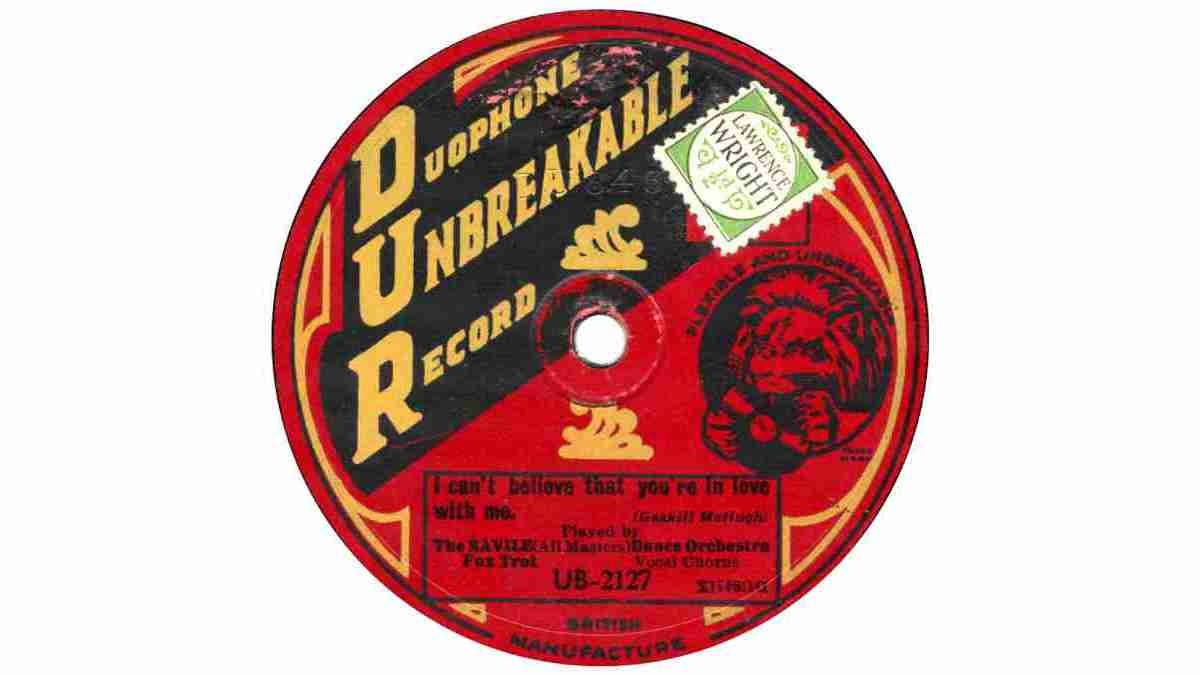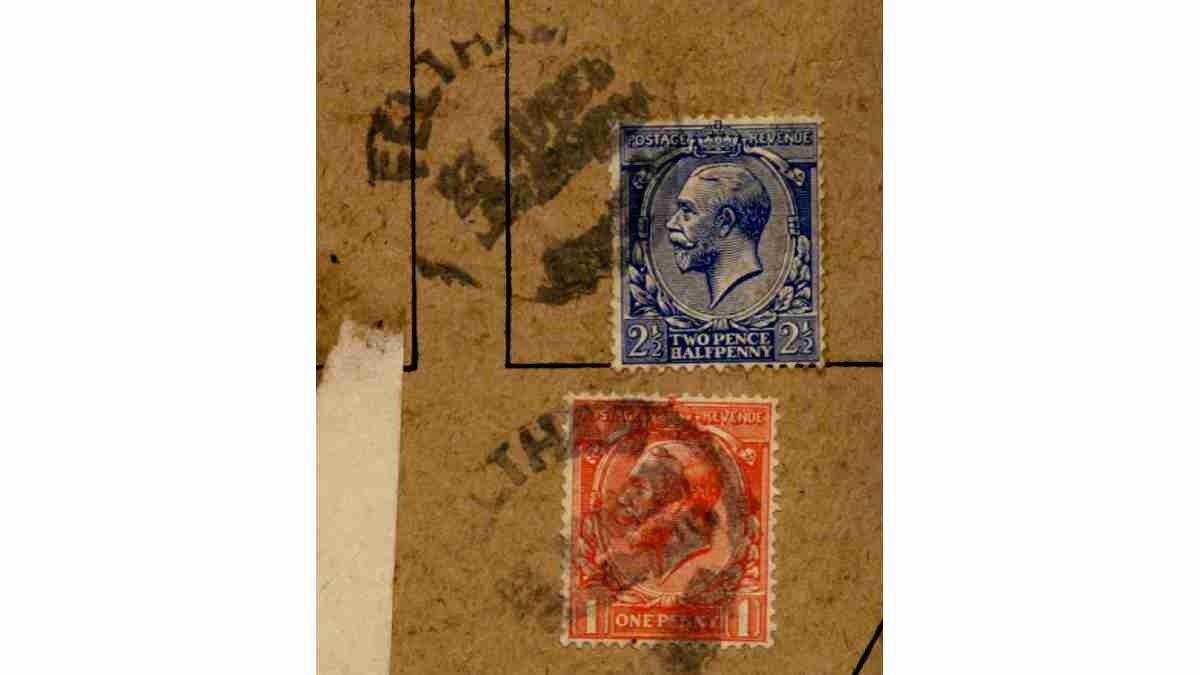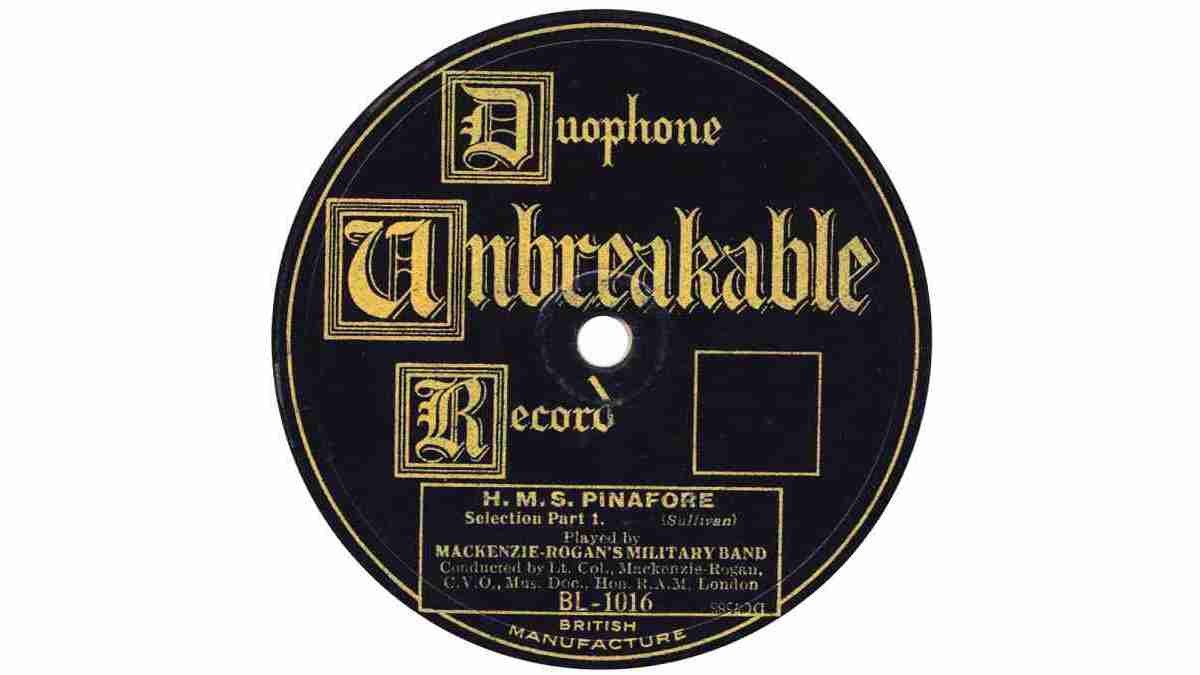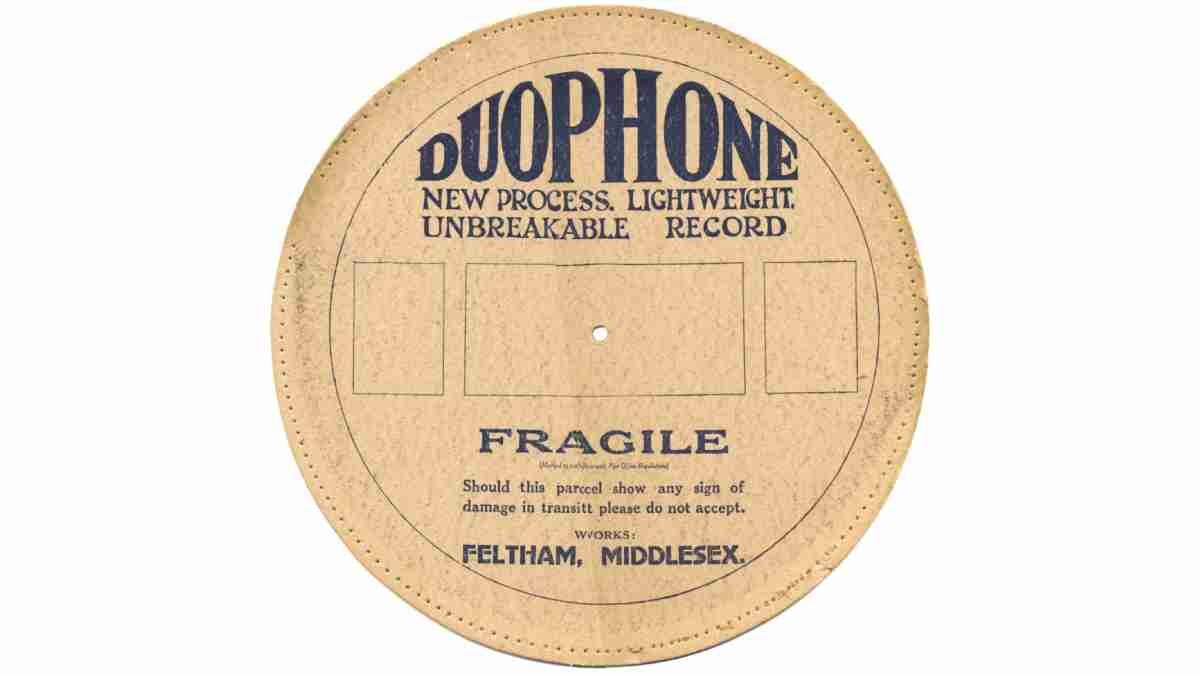
Early British record labels 1898-1926: D
Dacapo | Darling's Dreams | Defiance | Derby | Diamond 1 | Diamond 2 | Diamond 3 | Diamond Disc | Diploma | Dixy | Dreadnought | Duophone | Durafit
Dacapo
I have not yet located Frank Andrews’ writings on Dacapo. Dacapo was an important German company, who supplied masters and pressed a number of client labels for the U.K. They began here in 1910, and continued until late 1913 or early 1914, when the company was absorbed into the ever-growing Carl Lindström A.G., along with Favorite and Lyraphon. It is said that their rather plain green labels with gold printing was inspired by Zonophone, or rather ‘The International Zonophone Co.”, as Zono. had enjoyed immense early success in Europe; so Dacapo took a similar label. They sold well, and are quite frequently found to this day in the 10″ size; the 12″ with their attractive ‘lakescape’ are much less common.
Darling's Dreams
Little is known of this 7″ label, except that it is early. Even the source of this discs is unknown. Bill Dean-Myatt says that they were not a Beka product. We have no idea of their date at all, except that it must, perforce, have been before August 1914.

Defiance
See Frank Andrews, HD 228, 229. 1999-2000. The Disc Record Company in Harrow, Middx. went out of business in early 1915. However, the factory remained with its plating equipment, presses &c., and not least its stock of masters & stampers. These had come from various sources; some dated back to 1904. A firm called W H Reynolds Ltd. took a lease on the factory and its contents, renamed it The Reno Works, and announced in April 1915 that Defiance records were to be manufactured there. A special point was made that these were to be made of a new, smooth and unbreakable material. Another company associated with Reynolds’s was The Renoplex Mfg. Co. Ltd – that sounds as though it might have been involved in ‘materials technology’ – perhaps involving new, smooth unbreakable materials? Frank’s research has discovered that 24 sides were listed, of which 19 would be from the old DRC master pool. In any event, apart from an advert. in December 1915, Frank found no other mention of Defiance records, so their life must have been very short indeed, and their sales minuscule. (The rare image above appeared in monochrome in HD 229, having been sent in by Eddie Shaw in response to Frank’s entry on Defiance in HD 228. A partially colourised version was recently (2016) discovered in Frank’s paper archives by Bill Dean-Myatt, who kindly forwarded it here. It has been adjusted and re-colourised to give an impression of what the label may have looked like. Issued in 1915, ‘Cocoanut Dance’ is from American Record, by the Regimental Band of the Republic. It was recorded around 1905, and soon afterwards, issued in the U.K. as an American Odeon Record. Many of these masters ended up as part of the stock-in-trade of the DRC.)
Note: I have a Pioneer disc, pressed at Harrow, which cross-couples one side each of Pioneer 137 and 139 – both bearing the appropriate label. It is not a normal shellac pressing, being rather flexible and with a very silent surface. Six ordinary Harrow Pioneer pressings were weighed. The range was 211g to 247g, the average 233g. This unusual smooth, rather flexible Pioneer weighs only 167g. I have a strong hunch it’s a trial pressing made during the early days of the Reno Works period – a test record pressed in ‘Renoplex’, as the Defiants were?
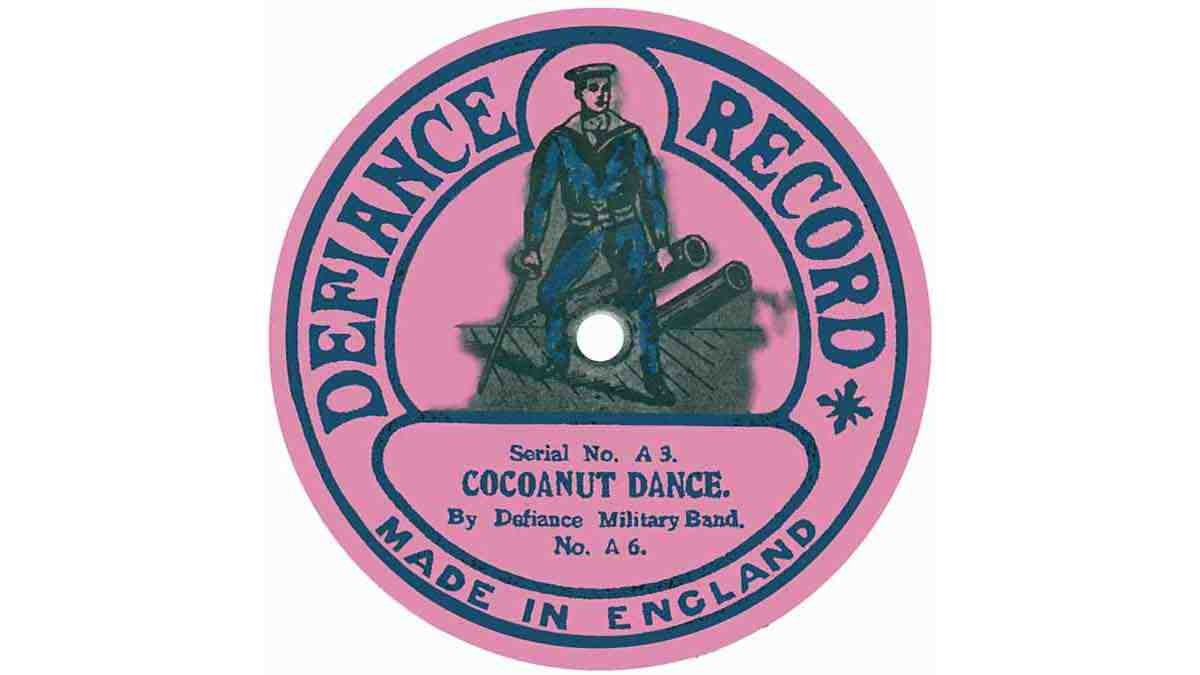
Derby
See Frank Andrews, HD 229. A shadowy, mysterious label. Even Frank never saw one, though he had details of a single example, with catalogue number 2500, credited to the Metropole Military Band. Only now, early 2020, has Ern Taylor very kindly sent this image from Australia. Frank did detect a mention of the label in a legal case in August 1914, when a William Burman of City Road, was said to be the sole British agent for Derby records. What the case was about, Frank did not vouchsafe; but he told us that the label had a horse and jockey on the label, like Winner. They had appeared in Germany in 1910, a product of the Turmalin-Werke Derby Record Co. Now; if the 1910 label had the horse & Jockey label, that was very interesting; because a British Syndicate produced the ‘Winner’ record in 1912, and that, of course, used the same horse & jockey trade mark for many years. The simplest explanation might be that Derby indeed had the jockey in 1910, but did not apply for British registration of the design. The Winner Syndicate registered the mark here in 1912. Now suppose, in the Price War of late 1913 onwards, William Burman of City Road, had imported a consignment of Derbys from Germany. Winner, by that time owned by Edison Bell, would have been down on him like a ton of bricks for copying their trade mark! The date of the legal case, August 1914, the month the Great War broke out, bought immense anti-German feeling, so discs made in Germany (which very many always had been) were suddenly anathema. So these Derbys would be impossible to sell, which accounts for their extreme rarity?
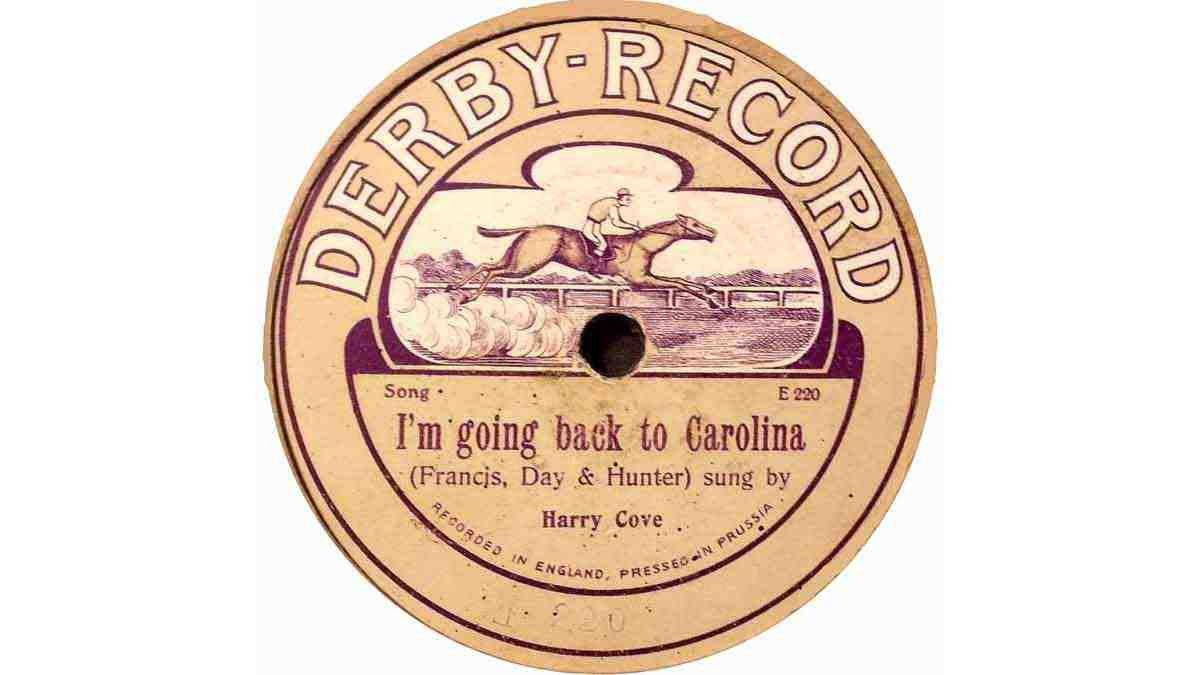
Diamond 1
See Frank Andrews, HD 229, 2000. Dark blue or black label with gold printing. Only a handful are known. Most were pressed in Germany from Blum & Co. masters. Those masters resided at the Kalliope factory in Saxony and were exclusive to Blum & Co., but Blum knew – or believed – that Kalliope had used them to press discs for others, & so terminated the connection. That is why even Frank is uncertain where in Germany they were pressed; some of the master numbers on Diamond may be higher than those which resided in Saxony. Moreover, Diamond records were not advertised in the trade press, an indication that they might have been sold on the ‘tallyman’ system – see John Bull and Meloto for explanation. In any case, the label is extremely rare and can only be vaguely dated to around 1913.
Diamond 2
See Frank Andrews, HD 229, 2000. This was a Beka trade mark in Germany in 1912. It was also registered at Stationer’s Hall in London. In his article, Frank reproduces the design, and points out its similarity to the label of Diamond – 1 above, having only the reservation that a Beka marque would not use masters from the same source(s) as Diamond – 1. He remarks that that the inter-relationship of these labels needs to be sorted out. If they are separate labels this one can only have existed between 1912 and 1914.
Diamond 3
The Diamond catalogue is listed in full in the first 50 pages of volume II of Mike Langridge’s monumental Pathé listings, published by the CLPGS. Go to www.clpgs.org.uk , click on ‘Shop’, then ‘Bookshop’, then ‘Label Discographies’ to see these and many other listings &c.
Originally written up by Len Watts and Frank Andrews, HD 108, 1979. 10.5″ vertically cut, etched label with blue infill, outside start. They were made for Diamond Disc Record Ltd. by Pathé Frères in London, and appeared in January 1915. They drew principally from Pathé’s own repertoire, but new recordings were also made. In 1916 the firm was absorbed by Pathé. They were very reasonably priced at 1/6d (7.5p), but all costs rose during the war, as the 2/- sticker shows. Towards the end, paper labels were then used, as on 0416. They continued in business until 1919, by which time 419 discs had been issued. (The highest catalogue number is 428, but nine numbers were never used.) They are still occasionally found.
Diamond Disc (Edison - see under Edison) Dinky
See Arthur Badrock, TMR 93, 1996; also Frank Andrews, HD 229, 2000, p24. Made for an unknown customer (who sold them at an unknown price) by J E Hough Ltd. – generally known as ‘Edison Bell’. They were 5.375″ (13.5 cm) diameter, and appeared in 1924. Masters were derived from that company’s The Bell mini-discs, which had been in production for about 3 years. The Bell was increased to 6″ (15.3cm) in 1926, but there are no Dinkys of that size. As usual with these small and cheap labels, one current song – such as the big hit ‘Dream Daddy’ above – was backed with a non-copyright item, or else there would have been a one penny royalty payable on the disc. In such a case, if Dinkys sold – for example – at one shilling (5p), one twelfth of that would be paid over as royalty. This is just over 8% of the retail price, while the required royalty was only 5% of the retail. Yet the minimum royalty was set at one halfpenny. Record companies were certainly not going to over-pay, hence the non-copyright backing side.
Diploma
See Frank Andrews, HD 229, 2000, and equally TMR 75, 1988, for an extensive article on J.L. Blum and his labels. Diploma is one of three closely related labels; the others being Stella and Victory. Some Diplomas (but not Stellas or Victorys) such as G-4 above, were pressed by ‘Edison Bell’ from its Bell Disc or Velvet Face masters, and are easily told by their 10.5″ (~27cm) diameter. Others, 10″ (25cm), were made in Saxony by Kalliope, though we have no example to figure here. The proprietor was Blum & Co. They were prolific in their issues, several hundred being made. Many of the couplings appeared on all three labels. They were around from about 1910-1914, just possibly into 1915. Diploma A70 above seems to be having a bit of an ‘identity crisis’: it is a Diploma, but bears the ship normally to be found on the Victory label. After a dispute, Blum severed his connection with Kalliope, and had fresh recordings made in London, which were pressed by an unknown firm in Prussia. The Great War then intervened, and naturally, German imports disappeared. Again, Blum commissioned new recordings, which were pressed by the Disc Record Company at Harrow, Middx., in which Blum seems to have become an important figure. Notable is the red, white & blue ‘Patriotic Issue’. By late 1914, the D.R.C. was under great stress; in spite of good demand for records, their presses could not keep up with the demand, so turnover declined. This, ironically, resulted in the winding up of the company; its formal dissolution occurred in June 1915.
Dixy
See Frank Andrews & Arthur Badrock, TMR 68, 1984; also Frank Andrews, HD 229, 2000, pp27-8. In 1926, a series of 6″ (5.25cm) records were recorded and pressed by HMV, to the order of the British Homophone Company. Homophone intended these as cheap lines both for themselves (Homo-Baby, Sterno-Baby), and other clients: Conquest was for Woolworths – though that deal never took off – while Jolly Boys and Dixy were both supplied to unknown concerns. Overall, the exercise cannot have been a success, for all five labels are scarce – e.g., no illustration of a Dixy was available for the 1984 TMR article cited above. All these micro-discs were recorded acoustically; it is conjectured that the one-penny-per-disc royalty payable to Western Electric for the use of their new system, would have rendered the whole exercise futile. However, it seems to have been a failure in any case. But thanks to the meticulous work of Alan Kelly in the EMI archives, at least we know that ‘Rastus On Parade’ was recorded on 5th March 1926, by a small ensemble directed by George Byng!
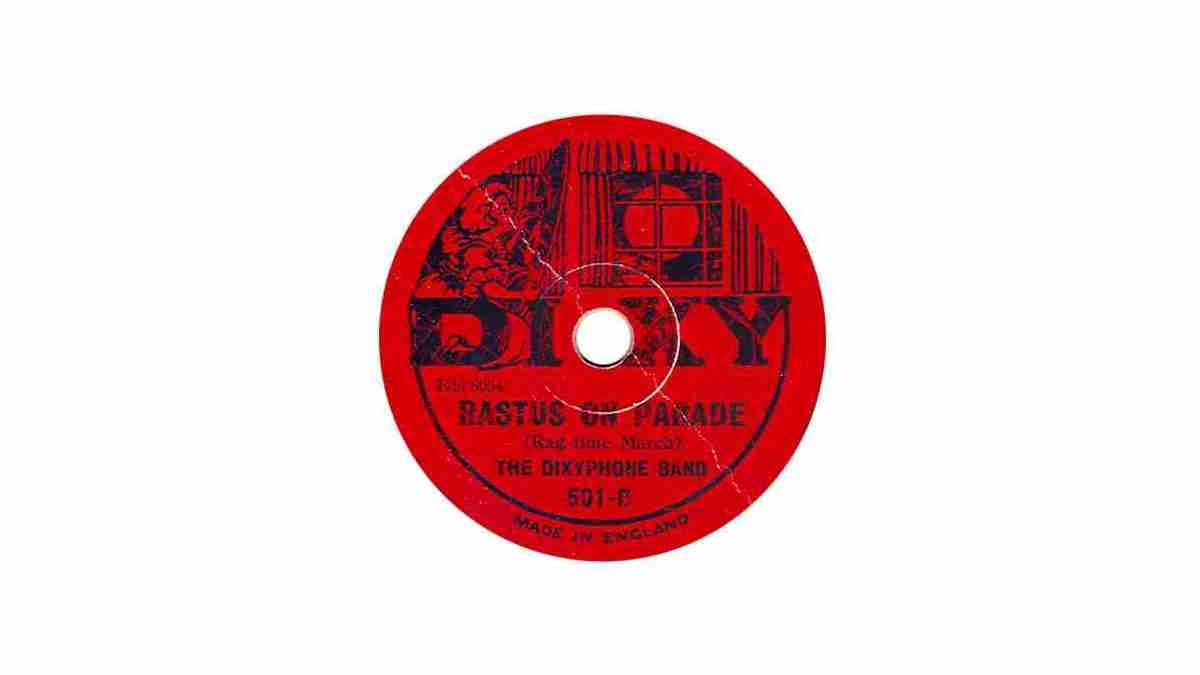
Dreadnought
See Frank Andrews, HD 229. Dreadnought Records are another example of the re-naming of old, deleted or bankrupt stock by re-labelling. A Dreadnought label was reported to Frank as being stuck over a Coliseum record. Whether it was a complete round label, or a partial one was not vouchsafed; but the sticker read: ‘Genuine British Manufacture’ – while the Coliseum was of German make. Their labels said: ‘Recorded in London, Reproduced in Prussia’ – which nobody would buy after the outbreak of war in August 1914. Who made these Dreadnoughts is, of course, completely unknown.
Duophone
Duophone records were around for several years from about 1924. The ‘DSL’ monogram stands for ‘Duophone Syndicate Ltd.’ – or at least I think so. The Duophone was a gramophone with two sound-boxes, as shown on the first labels. Yes, you guessed: one responded to the lower frequencies on the disc, the other to the higher. A commendable idea, though alas, before its time. Indeed, apart from Arnold Sugden’s brilliantly simple stereo system (which he developed in the mid-1950s), we cannot think of any other example of one stylus linked to two transducers. Perhaps that time is yet to come? Still, the Duophone people wanted records to go with the machine. These were readily furnished by The Aeolian Company, and were pressed at Hayes, Middlesex, in the Universal Music Co.’s factory. Original recordings were made, and supplemented by masters of U.S. origin from Vocalion and Gennett. These still turn up from time to time. More ambitious fare appeared on the 12″ (30cm) A- series. These are very scarce. Still more prestigious and expensive was the 12″ ‘Gold Seal’ GS- series of perhaps a dozen issues (one also on 10″), with their operatic vocals and violin solos. It goes without saying that these are very scarce indeed. Later, a new concept was introduced. Since the 1890s, the Unbreakable Record had been the most persistent ignis fatuus of the record industry. The Duophone version, two thin flexible layers laminated onto a paper-like core, apparently worked well originally in 1925/6. Surviving examples in god condition play tolerably well; but of course the materials technology of that era was not yet up to long-term stability. A red label UB- series with the same design was also produced, which eventually bore electrical recordings. The very dark blue BL- series is apparently a scarce oddity. A spin-off of unbreakabity meant that they could be sent through the post in a stiff carboards sleeve. The one illustrated contained a pale violet disc of the Irwell Springs Bacup Brass band, which plays rather well. As you can see, it cost threepence halfpenny to post on 23rd July. That would be er… 1925? Later, electrical recordings were produced on other series, both in black-label ‘indestructible’ format and also in violet-label shellac type, but alas, these, and the subsequent history of the company, its studio and its factory (which is indeed fascinating), is outside the scope of these pages.
Durafit
William Dean-Myatt kindly sent us this image of an advertising or promotional record, explaining:
DURAFIT. Made for S. Redmayne & Sons Ltd., Durafit House, Station Road, Wigton, Cumberland by Columbia. Advertisements in newspapers from the Western Borders region, dated August – November 1917, tell us that the song, ‘There’s something in the make’ was written by Bert Lee (with Robert P. Weston?). If you called at any of their shops you could borrow the record, free for 14 days, or you could buy it for 1/6 (7½p). The song was also published as sheet music, but in this case, copies were free. Advertisements also tell us that the song sheet was re-published three times. The lyrics extol the durability of Durafit suits and also imply that they produce uniforms for the armed forces.
So now we know that the song would probably been recorded ca. May 1917, but who was Cecil Cooper, comedian? My feeling is that he was probably some regular Columbia artist, Stanley Kirkby? or Fred Douglas? perhaps, using a pseudonym. As to the reverse, this is ‘The Zampa Overture’ played by The imperial Guards Band, which may have derived from Phoenix 007 or more likely from a version made by The Silver Stars Band that was issued on Regal G-7094.
I think that successors to the original company are still in the tailoring busines, including one in New George Street, Mayfair, London and one still in Wigton.
